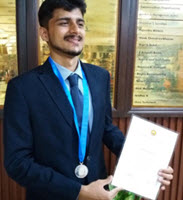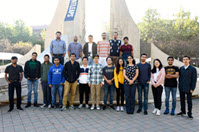
Hydrocarbon-degrading microbes living in ocean environments consumed and metabolized oil droplets following Deepwater Horizon, which significantly influenced the oil’s fate in the Gulf of Mexico. The ocean has layers of varying densities resulting from temperature or salinity gradients that can affect the motion of oil droplets and swimming microbes. Understanding the hydrodynamics of droplets and swimming microbes as they encounter these ocean layers is vital to understanding the biodegradation processes that follow an oil spill.
Rajat Dandekar uses mathematical theory to derive how stratified ocean environments affect the motion of flagellated organisms (microbes that move using a whip-like appendage called a flagella) and the movement of floating particles such as oil droplets. His research will improve our understanding about how stratified ocean environments influence the transport of oil droplets and microbial degradation processes.
Rajat is a Ph.D. student with Purdue University’s Department of Mechanical Engineering and a GoMRI Scholar with the project Role of Microbial Motility for Degradation of Dispersed Oil.
His Path

During his childhood in Pune, India, Rajat discovered that he could use mathematics and a simple pen and paper to make logical deductions about nature. He recalls learning about the golden ratio and Fibonacci sequence in flowers and plants, finding satisfaction in applying mathematical principles to the natural world. He completed a Bachelor of Technology in Engineering Design and Master of Technology in Automotive Engineering at the Indian Institute of Technology Madras, where he was introduced to fluid dynamics. “I learned that physical phenomena involving fluid motion can be understood by reducing their physics to a set of equations and then solving those equations,” he said. “The realization that mathematics, which already fascinated me, could be used to study real-world problems got me more interested in the field of fluid dynamics.”
Rajat began researching fluid dynamics Ph.D. programs and read several research papers detailing complex flow experiments conducted by Dr. Arezoo Ardekani at Purdue University. Dr. Ardekani’s lab team combined theoretical and computational techniques to investigate the motion of swimming microorganisms and transport of particles and droplets in aquatic environments. Rajat was intrigued by the group’s methods and joined Dr. Ardekani’s team conducting GoMRI-funded research investigating how oil-water interfaces affect marine bacteria’s motility as they move towards and attach to dispersed oil.
His Work
To understand Rajat’s research, it’s helpful to start with how microorganisms swim. “Humans swim by pushing through water with their body. However, microorganisms are typically very small and cannot exert such inertial forces on the fluid,” he explained. “Instead, these organisms have evolved so that they can propel themselves through ocean and lake environments. For example, some organisms rhythmically beat their flagella, while some synchronize cilia on their surface in such a way that the organism is able to move itself.”
Rajat focused first on understanding how stratified ocean environments affected flagellated organisms’ speed and energy consumption. He spent a semester conducting a literature review and learning more-nuanced mathematical techniques. He then derived equations using a mathematical technique called perturbation theory, which incorporated the complex Navier-Stokes equations that describe fluid motion into his calculations of flagellated organisms’ movement. He observed that density variations in the ocean significantly reduced flagellated organisms’ speed and caused them to consume more energy while swimming.
Rajat turned his focus next to calculating the transport of particles in stratified oceans, including their rotation and if they experience force and torque. He utilized his understanding of perturbation theory to develop a mathematical solution for calculating these particles’ rotation and the force and torque they experience in aquatic environments. “The theory can be applied for analyzing the motion of particles with any arbitrary shape [such as oil droplets],” explained Rajat. “An important application [of the theory] is the motion of droplets in aquatic environments, which can be used to understand oil droplets’ motion during an oil spill.”
Rajat’s theory revealed that even weak density variation generated more drag on particles than did fluid with a constant density. His calculations indicate that skew particles (particles that are highly deformed and asymmetric) experience hydrodynamic torque and rotate due to density stratification while non-skew particles (particles with shapes including spheres, ellipses, cubes, and rods) do not. He and his colleagues are now applying this theory to oil droplets (which can be skew or non-skew depending on their shape) to better understand their movement in stratified oceans.
His Learning
The friendly and motivating atmosphere in Dr. Ardekani’s lab created a positive environment that helped Rajat grow as a researcher and individual. He recalled having stimulating discussions with lab members about the research and each other’s philosophies and receiving encouragement from Dr. Ardekani to keep improving the research’s quality without stopping too early. Rajat further learned the value of discussing research with experts and other graduate students in the field when he presented his research at the 2019 American Physical Society’s Division of Fluid Dynamics Annual Meeting. His conference experience motivated him to pursue the next phase of his research: understanding the motion of flagellated microorganisms in heterogeneous media.
Rajat hopes to continue conducting research on exciting issues. “Many times, you are unsure whether the problem you are looking at is solvable with the scientific means at your disposal,” he said. “I am learning to embrace the uncertainty associated with conducting research.”
Praise for Rajat
Dr. Ardekani praised Rajat’s creativity, dedication, innovation, and theoretical skillset and described him as a brilliant student. She explained that Rajat’s research has made important contributions to the field of fluid dynamics by developing theoretical descriptions of particle transport and motile organisms in different fluid media. “Rajat joined my group when he started his Ph.D. in the fall of 2018,” she said. “Since then, he has impressed me in every meeting with his progress and productivity.”
The GoMRI community embraces bright and dedicated students like Rajat Dandekar and their important contributions. The GoMRI Scholars Program recognizes graduate students whose work focuses on GoMRI-funded projects and builds community for the next generation of ocean science professionals.
By Stephanie Ellis and Nilde Maggie Dannreuther. Contact sellis@ngi.msstate.edu for questions or comments.
************
The Gulf of Mexico Research Initiative (GoMRI) is a 10-year independent research program established to study the effect, and the potential associated impact, of hydrocarbon releases on the environment and public health, as well as to develop improved spill mitigation, oil detection, characterization and remediation technologies. An independent and academic 20-member Research Board makes the funding and research direction decisions to ensure the intellectual quality, effectiveness and academic independence of the GoMRI research. All research data, findings and publications will be made publicly available. The program was established through a $500 million financial commitment from BP. For more information, visit http://gulfresearchinitiative.org/.
© Copyright 2010-2020 Gulf of Mexico Research Initiative (GoMRI) – All Rights Reserved. Redistribution is encouraged with acknowledgement to the Gulf of Mexico Research Initiative (GoMRI). Please credit images and/or videos as done in each article. Questions? Contact web-content editor Nilde “Maggie” Dannreuther, Northern Gulf Institute, Mississippi State University (maggied@ngi.msstate.edu).
